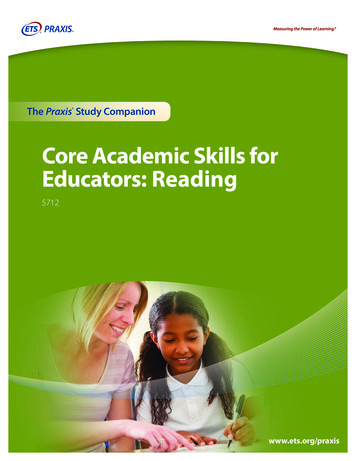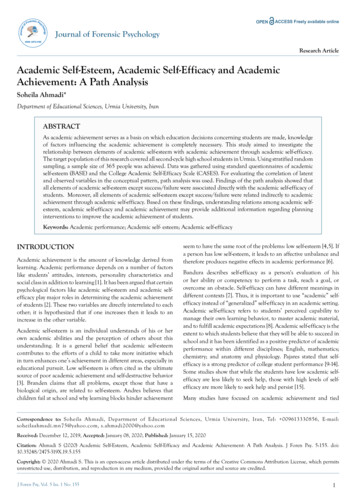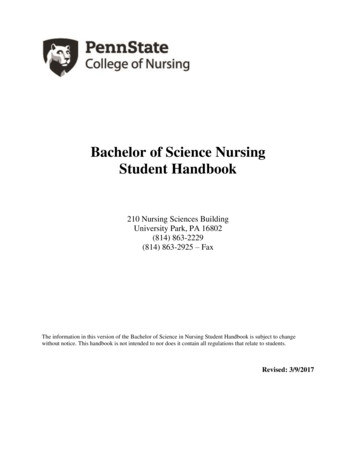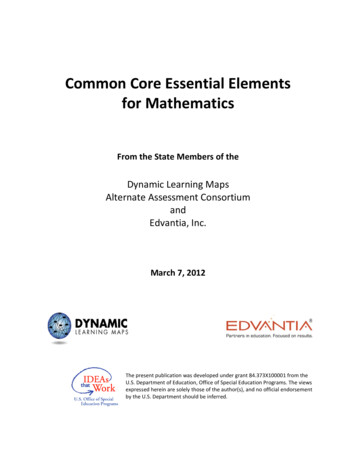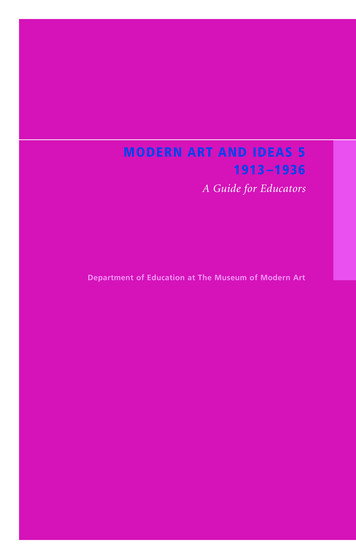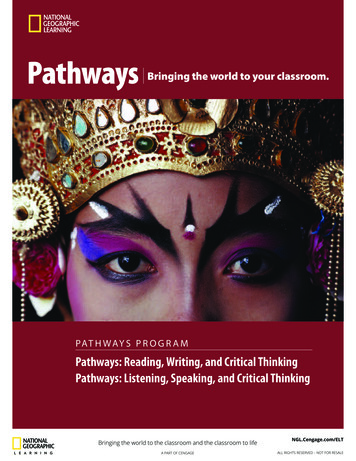
Transcription
The Praxis Study CompanionCore Academic Skills forEducators: Mathematics5732www.ets.org/praxis
Welcome to the Praxis Study CompanionWelcome to The Praxis Study CompanionPrepare to Show What You KnowYou have been working to acquire the knowledge and skills you need for your teaching career. Now you areready to demonstrate your abilities by taking a Praxis test.Using the Praxis Study Companion is a smart way to prepare for the test so you can do your best on test day.This guide can help keep you on track and make the most efficient use of your study time.The Study Companion contains practical information and helpful tools, including: An overview of the Praxis tests Specific information on the Praxis test you are taking A template study plan Study topics Practice questions and explanations of correct answers Test-taking tips and strategies Frequently asked questions Links to more detailed informationSo where should you start? Begin by reviewing this guide in its entirety and note those sections that you needto revisit. Then you can create your own personalized study plan and schedule based on your individual needsand how much time you have before test day.Keep in mind that study habits are individual. There are many different ways to successfully prepare for yourtest. Some people study better on their own, while others prefer a group dynamic. You may have more energyearly in the day, but another test taker may concentrate better in the evening. So use this guide to develop theapproach that works best for you.Your teaching career begins with preparation. Good luck!Know What to ExpectWhich tests should I take?Each state or agency that uses the Praxis tests sets its own requirements for which test or tests you must take forthe teaching area you wish to pursue.Before you register for a test, confirm your state or agency’s testing requirements at www.ets.org/praxis/states.How are the Praxis tests given?Praxis tests are given on computer. Other formats are available for test takers approved for accommodations (seepage 36).The Praxis Study Companion2
Welcome to the Praxis Study CompanionWhat should I expect when taking the test on computer?When taking the test on computer, you can expect to be asked to provide proper identification at the testcenter. Once admitted, you will be given the opportunity to learn how the computer interface works (how toanswer questions, how to skip questions, how to go back to questions you skipped, etc.) before the testing timebegins. Watch the What to Expect on Test Day video to see what the experience is like.Where and when are the Praxis tests offered?You can select the test center that is most convenient for you. The Praxis tests are administered through aninternational network of test centers, which includes Prometric Testing Centers, some universities, and otherlocations throughout the world.Testing schedules may differ, so see the Praxis web site for more detailed test registration information at www.ets.org/praxis/register.The Praxis Study Companion3
Table of ContentsTable of ContentsThe Praxis Study Companion guides you through the steps to success1. Learn About Your Test.5Learn about the specific test you will be taking2. F amiliarize Yourself with Test Questions.8Become comfortable with the types of questions you’ll find on the Praxis tests3. Practice with Sample Test Questions. 12Answer practice questions and find explanations for correct answers4. Determine Your Strategy for Success. 20Set clear goals and deadlines so your test preparation is focused and efficient5. Develop Your Study Plan. 23Develop a personalized study plan and schedule6. Review Study Topics. 27Review the content that the test covers7. Review Smart Tips for Success. 34Follow test-taking tips developed by experts8. Check on Testing Accommodations. 36See if you qualify for accommodations that may make it easier to take the Praxis test9. Do Your Best on Test Day. 37Get ready for test day so you will be calm and confident10. Understand Your Scores. 39Understand how tests are scored and how to interpret your test scoresAppendix: Other Questions You May Have . 41The Praxis Study Companion4
Step 1: Learn About Your Test1. Learn About Your TestLearn about the specific test you will be takingCore Academic Skills for Educators: Mathematics (5732)Test at a GlanceTest NameCore Academic Skills for Educators: MathematicsTest Code5732Time85 minutesNumber of Questions56FormatSelected-response questions—select one answer choiceSelected-response questions—select one or more answer choicesNumeric entry questionsOn-screen calculator availableTest DeliveryComputer deliveredContent CategoriesApproximateNumber ofQuestions*ApproximatePercentage ofExaminationI.Number and Quantity1730%II.Algebra and Functions1730%III. Geometry1120%IV. Statistics and Probability1120%IVIIIIII* Includes both scored and unscored (pretest) questions. Depending on thenumber of pretest questions included in each scoring category, the total numberof questions in that category may vary from one form of the test to another.About This TestThe Core Academic Skills for Educators test in Mathematics measures academic skills in mathematics needed toprepare successfully for a career in education. All skills assessed have been identified as needed for college andcareer readiness, in alignment with the Common Core State Standards for Mathematics. The test will cover fourmajor content areas: Number and Quantity, Algebra and Functions, Geometry, and Statistics and Probability.Focus is on key concepts of mathematics and the ability to solve problems and to reason in a quantitativecontext. Many of the problems require the integration of multiple skills to achieve a solution.In Number and Quantity, the understanding of order among integers, representation of a number in more thanone way, place value, properties of whole numbers, equivalent computational procedures, ratio, proportion, andpercent are emphasized. Algebra assesses the ability to manipulate equations and inequalities, recognition ofvarious ways to solve a problem, relationship between verbal and symbolic expressions, and graphs. Functionsquestions test the knowledge of basic function definitions and the relationship between the domain and rangeof any given functions.The Praxis Study Companion5
Step 1: Learn About Your TestGeometry assesses the understanding and applicationof the characteristics and properties of geometricshapes, the Pythagorean theorem, transformation, anduse of symmetry to analyze mathematical situations.Knowledge of basic U.S. customary and metricsystems of measurement is assumed. Statistics andProbability assesses the ability to read and interpretvisual display of quantitative information, understandthe correspondence between data and graph, makeinferences from a given data display, determine mean,median, and mode, and assign a probability to anoutcome.The test is 85 minutes long and contains 56 questions.This test may contain some questions that will notcount toward your score.The test will contain several types of questions: Selected-response question—select one answerchoice: These questions are selected-responsequestions that ask you to select only one answerchoice from a list of five choices. Selected-response question—select one or moreanswer choices: These questions are selectedresponse questions that ask you to select one or moreanswer choices from a list of choices. A questionmay or may not specify the number of choices toselect. These questions are marked with square boxesbesides the answer choices, not circles or ovals. Numeric entry questions: Questions of this type askyou to enter your answer as an integer or a decimal ina single answer box, or to enter it as a fraction in twoseparate boxes—one for the numerator and one forthe denominator. In the computer-based test, use thecomputer mouse and keyboard to enter your answer.An on-screen calculator, shown below, is available forthis test. The Transfer Display button can be used onnumeric entry questions with a single answer box totransfer the calculator display to the answer box.Please consult the Praxis Calculator Use web pagefor further information, and review the directions forusing the on-screen calculator.Test SpecificationsTest specifications in this chapter describe theknowledge and skills measured by the test. Studytopics to help you prepare to answer test questionscan be found on page 27.I. Number and QuantityA. Ratios and Proportional Relationships1. Understand ratio concepts and use ratioreasoning to solve problems2. Analyze proportional relationships and use themto solve real-world and mathematical problemsB. The Real Number System1. Apply understanding of multiplication anddivision to divide fractions by fractions2. Compute fluently with multi-digit numbers andfind common factors and multiples3. Apply understanding of operations with fractionsto add, subtract, multiply, and divide rationalnumbers4. Know that there are numbers that are notrational, and approximate them by rationalnumbers5. Work with radicals and integer exponentsC. Quantities1. Reason quantitatively and use units to solveproblemsThe Praxis Study Companion6
Step 1: Learn About Your TestII.Algebra and FunctionsIII.A. Seeing Structure in ExpressionsGeometryA. Congruence and Similarity1. Apply understanding of arithmetic to algebraicexpressions1. Draw, construct, and describe geometrical figuresand describe the relationships between them2. Solve real-life and mathematical problems usingnumerical and algebraic expressions2. Experiment with transformations in the planeB. Right Triangles3. Use properties of operations to generateequivalent expressions1. Understand and apply the Pythagorean theoremC. CirclesB. Reasoning with Equations and Inequalities1. Understand and apply theorems about circles1. Understand the connections betweenproportional relationships, lines, and linearequationsD. Geometric Measurement and Dimension2. Understand solving equations as a process ofreasoning and explain the reasoning1. Solve real-life and mathematical problemsinvolving angle measure, area, surface area, andvolume3. Reason about and solve one-variable equationsand inequalities2. Explain volume formulas and use them to solveproblemsE. Modeling with Geometry4. Solve equations and inequalities in one variable1. Apply geometric concepts in modeling situations5. Analyze and solve linear equations and pairs ofsimultaneous linear equations6. Represent and solve equations and inequalitiesgraphicallyC. FunctionsIV.Statistics and ProbabilityA. Basic Statistics and Probability1. Develop understanding of statistical variability1. Interpreting functions2. Summarize and describe distributions2. Building functions3. Use random sampling to draw inferences about apopulation4. Investigate chance processes and develop, use,and evaluate probability models5. Investigate patterns of association in bivariatedataB. Interpreting Categorical and Quantitative Data1. Summarize, represent, and interpret data on asingle count or measurement variable2. Interpret linear modelsC. Making Inferences and Justifying Conclusions1. Understand and evaluate random processesunderlying statistical experimentsD. Using Probability to Make Decisions1. Use probability to evaluate outcomes ofdecisionsThe Praxis Study Companion7
Step 2: Familiarize Yourself with Test Questions2. Familiarize Yourself with Test QuestionsBecome comfortable with the types of questions you’ll find on the Praxis testsThe Praxis assessments include a variety of question types: constructed response (for which you write aresponse of your own); selected response, for which you select one or more answers from a list of choices ormake another kind of selection (e.g., by clicking on a sentence in a text or by clicking on part of a graphic); andnumeric entry, for which you enter a numeric value in an answer field. You may be familiar with these questionformats from taking other standardized tests. If not, familiarize yourself with them so you don’t spend timeduring the test figuring out how to answer them.Understanding Computer-Delivered QuestionsQuestions on computer-delivered tests are interactive in the sense that you answer by selecting an optionor entering text on the screen. If you see a format you are not familiar with, read the directions carefully. Thedirections always give clear instructions on how you are expected to respond.For most questions, you respond by clicking an oval to select a single answer from a list of answer choices.However, interactive question types may also ask you to respond by: Clicking more than one oval to select answers from a list of answer choices. Typing in an entry box. When the answer is a number, you may be asked to enter a numerical answer.Some questions may have more than one place to enter a response. Clicking check boxes. You may be asked to click check boxes instead of an oval when more than onechoice within a set of answers can be selected. Clicking parts of a graphic. In some questions, you will select your answers by clicking on a location (orlocations) on a graphic such as a map or chart, as opposed to choosing your answer from a list. Clicking on sentences. In questions with reading passages, you may be asked to choose your answers byclicking on a sentence (or sentences) within the reading passage. Dragging and dropping answer choices into targets on the screen. You may be asked to select answersfrom a list of choices and drag your answers to the appropriate location in a table, paragraph of text orgraphic. Selecting answer choices from a drop-down menu. You may be asked to choose answers by selectingchoices from a drop-down menu (e.g., to complete a sentence).Remember that with every question you will get clear instructions.Perhaps the best way to understand computer-delivered questions is to view the Computer-delivered TestingDemonstration on the Praxis web site to learn how a computer-delivered test works and see examples ofsome types of questions you may encounter.The Praxis Study Companion8
Step 2: Familiarize Yourself with Test QuestionsUnderstanding Selected-Response QuestionsMany selected-response questions begin with the phrase “which of the following.” Take a look at this example:Which of the following is a flavor made from beans?(A) Strawberry(B) Cherry(C) Vanilla(D) MintHow would you answer this question?All of the answer choices are flavors. Your job is to decide which of the flavors is the one made from beans.Try following these steps to select the correct answer.1) L imit your answer to the choices given. You may know that chocolate and coffee are also flavors madefrom beans, but they are not listed. Rather than thinking of other possible answers, focus only on the choicesgiven (“which of the following”).2) E liminate incorrect answers. You may know that strawberry and cherry flavors are made from fruit andthat mint flavor is made from a plant. That leaves vanilla as the only possible answer.3) V erify your answer. You can substitute “vanilla” for the phrase “which of the following” and turn thequestion into this statement: “Vanilla is a flavor made from beans.” This will help you be sure that your answeris correct. If you’re still uncertain, try substituting the other choices to see if they make sense. You may wantto use this technique as you answer selected-response questions on the practice tests.Try a more challenging exampleThe vanilla bean question is pretty straightforward, but you’ll find that more challenging questions have asimilar structure. For example:Entries in outlines are generally arranged accordingto which of the following relationships of ideas?(A) Literal and inferential(B) Concrete and abstract(C) Linear and recursive(D) Main and subordinateYou’ll notice that this example also contains the phrase “which of the following.” This phrase helps youdetermine that your answer will be a “relationship of ideas” from the choices provided. You are supposed to findthe choice that describes how entries, or ideas, in outlines are related.Sometimes it helps to put the question in your own words. Here, you could paraphrase the question in this way:“How are outlines usually organized?” Since the ideas in outlines usually appear as main ideas and subordinateideas, the answer is (D).The Praxis Study Companion9
Step 2: Familiarize Yourself with Test QuestionsQUICK TIP: Don’t be intimidated by words you may not understand. It might be easy to be thrown by wordslike “recursive” or “inferential.” Read carefully to understand the question and look for an answer that fits. Anoutline is something you are probably familiar with and expect to teach to your students. So slow down, anduse what you know.Watch out for selected-response questions containing “NOT,” “LEAST,” and “EXCEPT”This type of question asks you to select the choice that does not fit. You must be very careful because it is easyto forget that you are selecting the negative. This question type is used in situations in which there are severalgood solutions or ways to approach something, but also a clearly wrong way.How to approach questions about graphs, tables, or reading passagesWhen answering questions about graphs, tables, or reading passages, provide only the information that thequestions ask for. In the case of a map or graph, you might want to read the questions first, and then look at themap or graph. In the case of a long reading passage, you might want to go ahead and read the passage first,noting places you think are important, and then answer the questions. Again, the important thing is to be sureyou answer the questions as they refer to the material presented. So read the questions carefully.How to approach unfamiliar formatsNew question formats are developed from time to time to find new ways of assessing knowledge. Tests mayinclude audio and video components, such as a movie clip or animation, instead of a map or reading passage.Other tests may allow you to zoom in on details in a graphic or picture.Tests may also include interactive questions. These questions take advantage of technology to assessknowledge and skills in ways that standard selected-response questions cannot. If you see a format you arenot familiar with, read the directions carefully. The directions always give clear instructions on how you areexpected to respond.QUICK TIP: Don’t make the questions more difficult than they are. Don’t read for hidden meanings or tricks.There are no trick questions on Praxis tests. They are intended to be serious, straightforward tests ofyour knowledge.Understanding Constructed-Response QuestionsConstructed-response questions require you to demonstrate your knowledge in a subject area by creatingyour own response to particular topics. Essays and short-answer questions are types of constructed-responsequestions.For example, an essay question might present you with a topic and ask you to discuss the extent to which youagree or disagree with the opinion stated. You must support your position with specific reasons and examplesfrom your own experience, observations, or reading.Take a look at a few sample essay topics: “ Celebrities have a tremendous influence on the young, and for that reason, they have a responsibility toact as role models.” “ We are constantly bombarded by advertisements—on television and radio, in newspapers andmagazines, on highway signs, and the sides of buses. They have become too pervasive. It’s time to putlimits on advertising.” “ Advances in computer technology have made the classroom unnecessary, since students and teachersare able to communicate with one another from computer terminals at home or at work.”The Praxis Study Companion10
Step 2: Familiarize Yourself with Test QuestionsKeep these things in mind when you respond to a constructed-response question1) A nswer the question accurately. Analyze what each part of the question is asking you to do. If thequestion asks you to describe or discuss, you should provide more than just a list.2) A nswer the question completely. If a question asks you to do three distinct things in your response,you should cover all three things for the best score. Otherwise, no matter how well you write, you willnot be awarded full credit.3) A nswer the question that is asked. Do not change the question or challenge the basis of thequestion. You will receive no credit or a low score if you answer another question or if you state, forexample, that there is no possible answer.4) G ive a thorough and detailed response. You must demonstrate that you have a thoroughunderstanding of the subject matter. However, your response should be straightforward and not filledwith unnecessary information.5) R eread your response. Check that you have written what you thought you wrote. Be sure not toleave sentences unfinished or omit clarifying information.QUICK TIP: You may find that it helps to take notes on scratch paper so that you don’t miss any details. Thenyou’ll be sure to have all the information you need to answer the question.The Praxis Study Companion11
Step 3: Practice with Sample Test Questions3. Practice with Sample Test QuestionsAnswer practice questions and find explanations for correct answersSample Test QuestionsThis test is available via computer delivery. To illustrate what the computer-delivered test looks like, thefollowing sample question shows an actual screen used in a computer-delivered test. For the purposes of thisguide, sample questions are provided as they would appear in a paper-delivered test.The Praxis Study Companion12
Step 3: Practice with Sample Test QuestionsThe sample questions that follow illustrate the kinds of questions onthe test. They are not, however, representative of the entire scope ofthe test in either content or difficulty. Answers with explanationsfollow the questions.Directions: Questions 1-12 below are followed by fivesuggested answers or completions. Select the one that isbest in each case and then click on the oval to the left ofyour choice. For innovative question types, click on the boxand type in the correct answer (questions 13-14) or click onone or more answers (question 15).Remember, try to answer every question.2. In the figure above, C is the center of the circle.Which of the following must be true?(A) QC and RC have the same length.(B) QR and RC have the same length.(C) QC is perpendicular to QR.(D) QR is perpendicular to RC.(E) QRC is equilateral.1. In the Venn diagram above, circle G representsthe integers 2 to 10, inclusive, and circle Hrepresents the integers 6 to 12, inclusive. Howmany integers are represented by the shadedregion?(A) Two(B) Three(C) Four(D) Five(E) Sixxy0521162372610353. Which of the following equations expresses therelationship between x and y in the tableabove?(A) y x 5(B) y x 6(C) y 3 x 5(D) y 4 x - 1(E) y 4 x - 5The Praxis Study Companion13
Step 3: Practice with Sample Test QuestionsMen12Women18Boys10Girls84. The table above shows the distribution of men,women, boys, and girls in a group of 48individuals. If one individual is to be randomlyselected from the group, what is the probabilitythat the individual selected will be a woman?(A)118(B)215143(D)81(E)2(C)5. When 641.29 is divided by 10, which digit ofthe resulting number is in the tens place?(A) 1(B) 2(C) 4(D) 6(E) 96. If x 0 and y 0 , which of the following is3 1- ?equivalent to2x y(A)1xy(B)32xy(C)3 y - 2x2 xy(D)22x - y(E)3 y - 2x2x - yThe Praxis Study Companion7. The numbers of absences in Mrs. Klein’s classfor each of the first 3 months of the year were16, 12, and 17, respectively. If the average(arithmetic mean) number of absences for thefirst 4 months of the year was 14, how manyabsences were there in the 4th month?(A)9(B) 10(C) 11(D) 12(E) 138. At a computer store on Monday last week, theprice of a computer was x dollars. On Tuesdaythe price of the computer was reduced by 25%of Monday’s price. On Wednesday the price ofthe computer was further reduced by 40% ofTuesday’s price. Which of the followingexpressions represents the price, in dollars, ofthe computer on Wednesday?(A)(0.35)x(B)(0.4)(0.25)x(C) (0.4)(0.75)x(D)(0.6)(0.25)x(E)(0.6)(0.75)x9. If 4 x 14 9 y and y 2, what is the valueof x ?(A) 4(B) 5(C) 6(D) 7(E) 814
Step 3: Practice with Sample Test Questions10. In the xy-plane above, rectangle RSTW is to bereflected across the y-axis. What are thecoordinates of the point T after the reflection?(A)( 4, 5)(B)( 4, 2)12. The circle graph above shows the distributionof the Chang family’s vacation budget over fivecategories. According to the graph, for howmany of the five categories was the dollaramount of the budget category greater than 1,000 ?(C) ( 4, 5)(A) One(D)( 1, 5)(B) Two(E)(4, 5)(C) Three13- , , ,4811. When placed into the blank spaces above inincreasing order, which of the following pairs ofnumbers creates a list of numbers that isordered from least to greatest?1(A) - , 02(B) -1 1,8 3(C) -3 1,8 4(D) 0 ,(E)12(D) Four(E) FiveFor the following question, enter your answer inthe answer boxes.2of her monthly salary for51food, and last month she spentof her1013. Helen budgetsmonthly salary on produce. What fraction ofher budget for food was spent on produce lastmonth?1 2,3 5For the following question, enter your answer inthe answer box.14. A box of machine parts contains 6 times asmany usable parts as defective parts. If thereare exactly 882 parts in the box, how many ofthem are usable?The Praxis Study Companion15
Step 3: Practice with Sample Test QuestionsFor the following question, select all the answerchoices that apply.-2 x 14 615. Which of the following values of x are solutionsof the inequality above?Indicate all such values.(A) 2.65(B)0.75(C)3.84(D)4.23(E)4.79The Praxis Study Companion16
Step 3: Practice with Sample Test QuestionsAnswers to Sample Questionsif x 0 , then y 3(0) 5 5,1. The correct answer is (D). In the Venn diagram, theshaded region represents the integers that are in bothG and H; i.e., these integers are among the integers 2through 10 and also among the integers 6 through 12,or 6, 7, 8, 9, and 10, which amount to five integers. Theanswer, therefore, is choice (D).if x 2 , then y 3(2) 5 11,The answer, therefore, is choice (C).2. The correct answer is (A). Since C is the center of thecircle, QC and RC are both radii of the circle andtherefore have the same length. The answer, therefore,is choice (A).woman is 18 out of 48, or.D ifference in y-valuesD ifference in x-valuesFor example, if (6, 23) and (2, 11) are selected, theslope isSlope 23 - 116-2 124 3.The slope of the line is 3.The coordinate pairs in the table indicate that thefirst pair, (0, 5) , is the point at which the line crossesthe y-axis. Therefore, the y-intercept is 5.Use the slope-intercept equation, y mx b ,where m is the slope and b is the y-intercept. Whenthe slope and y-intercept of the line are known, theequation of the line can be found by usingsubstitution.Therefore, the equation y 3x 5 expresses therelationship between x and y in the table. Theanswer, therefore, is choice (C).Solution Strategy 2:The correct equation must hold when each of thefive pairs of values from the table is substituted for xand y. The equation y x 5 (1st choice) holds forthe pairs of values x 0 , y 5 , but not for the pairsof values x 2 , y 11 . The equations y x 6 ,y 4x 1 , and y 4x 5 (2nd, 4th, and 5thchoices) do not hold for the pairs of values x 0and y 5 . The equation y 3x 5 (3rd choice)holds for all five pairs of values given:The Praxis Study Companion4129ThousandthsSlope 6HundredthsWith any two coordinate pairs from the table, theslope of the line can be found using5. The correct answer is (D). When dividing a numberexpressed as a decimal by 10, the decimal point ismoved one place to the left, so 641.29 divided by 10 is64.129. The tens place is the second place to the left ofthe decimal point. In the number 64.129, that is thedigit 6.TenthsNote that all of the answer choices are linearequations. Therefore, the input and outputcoordinate pairs in the table represent points on aline.18 3 . The answer,48 8therefore, is choice (D).OnesSolution Strategy 1:4. The correct answer is (D). In the table provided, thereare 48 individuals in the group, 18 of whom are women.The probability that the individual selected will be aTens3. The correct answer is (C).if x 6 , then y 3(6) 5 23, and so forth.The answer, therefore, is choice (D).6. The correct answer is (C). Recall that in order tosubtract fractions with different denominators, acommon denominator must first be determined. Forexample, consider the following evaluation ofwhere each of the fractions3 1- ,5 231andare first52expressed as fractions with common denominator 10.3 1 3 æ2 ö 1 æ5 ö- ç - ç 5 2 5 è2 ø 2 è5 ø6 5 10 106 -5 101 10The same is true for
The Core Academic Skills for Educators test in Mathematics measures academic skills in mathematics needed to prepare successfully for a career in education. All skills assessed have been identified as needed for college and career readiness, in alignment with the Common Core State Standards for Mathematics. The test will cover four
